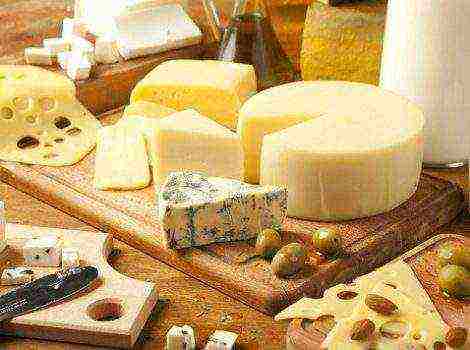Content
- 1 Early varieties of bell peppers for open field
- 2 Mid-season
- 3 Sweet pepper for Siberia
- 4 Varieties for the Moscow region
- 5 The best hybrid varieties
- 6 Description of the best late-ripening peppers
- 7 Thick-walled large-fruited varieties
- 8 The best peppers for stuffing and processing
- 9 Conclusion
- 10 Popular varieties of bell peppers
- 10.1 Early and mid-season varieties for open ground
- 10.2 Polycarbonate greenhouse varieties
- 10.2.1 Miracle Tree F1
- 10.2.2 The hybrid is recommended for growing in a greenhouse. High quality fruits are formed even with a lack of light. Resistant to apical fruit rot disease. Ripen amicably. The harvested crop is suitable for fresh use, good for processing. Pharaoh F1
- 10.2.3 Fat Baron
- 10.2.4 Cow's ear
- 10.2.5 Cockatoo
- 10.2.6 Gift from Moldova
- 10.2.7 Topolin
- 10.2.8 Ivanhoe
- 10.2.9 Hercules
- 11 Varieties of sweet peppers
- 12 The best option for the garden
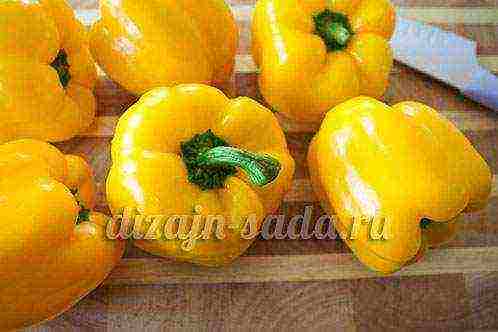
If I am asked what are the most successful varieties of sweet peppers (based on the results of last summer) I highlight, and which varieties and hybrids I will plant again, then I will answer:
- Red shovel
- Atlant
- Big Daddy
- gold reserve
- Bagheera
- Gingerbread man
- Cockatoo
- Tusk
- Fat Baron
- Siberian bonus
- Gemini F1
- Claudio F1
I consider these varieties and hybrids of peppers to be the best. They have passed two years of tests (and some more) and now they will once again take their rightful place in my garden.
If you have large greenhouses or you like experiments in the open field, then take a look at the rest of the varieties and hybrids on this page - they also deserve attention, and they are all good in their own way, but my plot sizes (unfortunately) are not unlimited, so I chose only the most favorite.
Pepper varieties with photos and descriptions, reviews
Pepper Apricot Favorite
An early ripe sweet pepper variety. The bush is low, only 40-50 cm.
Peppers are cone-shaped, smooth, weighing 100-120 g, with a wall thickness of 7 mm. This variety is grown outdoors and in greenhouses. It knits fruit well in any summer.
Pepper yield Apricot favorite high.
Agapovsky pepper
Medium early sweet pepper (99-120 days from the time of transplanting). The bushes are compact, with many leaves.
The fruits are cuboid, weighing about 130 g, with a wall thickness of 7.5-8 mm. The variety is resistant to diseases, intended for cultivation in greenhouses.
Agapovsky pepper yield: 9.5 - 10.3 kg per sq.m.
Pepper Atlant
Mid-season sweet pepper variety (70-75 days from germination to maturity), distinguished by large fruits. In biological maturity, these are red peppers with a diameter of 13-14 cm, a length of 18-20 cm with a wall thickness of 8-10 mm, with excellent taste.
Plant height 70-75 cm. This variety is grown both outdoors and indoors.
Atlant pepper yield: 3 - 5 kg / sq. m.
Pepper Tusk, description
An early ripening variety of sweet pepper, ripening in 95-105 days from the moment the seedlings are planted in the ground. The bushes are very tall, up to 160 cm.
Fruits are cylindrical, elongated, with a wall thickness of up to 8 mm and an average weight of 150 g. In biological maturity, the peppers are red. The taste is aromatic, sweet. Grown in the open field and in the greenhouse.
Sweet pepper yield Tusk: 2.6 kg / sq. m.
Pepper Big Dad, characteristic
An early ripe sweet pepper variety. The bush is compact.
Fruits are thick-walled, cylindrical, weighing 100 g, purple in color, and brown-red at biological maturity.
Grown in the open field and in greenhouses. It is recommended to plant seedlings according to the scheme: 50 x 30 cm. The variety is distinguished by disease resistance and yield stability.
Big Papa pepper yield: 6.8 - 7.2 kg / sq. m.
Pepper Bogatyr, description, photo
Medium early, high-yielding sweet pepper variety. On a well-developed bush, large, prismatic fruits, 15-18 cm long, with a wall thickness of about 7 mm and each weighing 150-180 g. Peppers are sweet, juicy, with a delicate peppery aroma. The height of the bush is 55-60 cm.
The variety is resistant to verticillary wilt.
The yield of pepper Bogatyr: 3.5 - 7 kg / sq.m.
Pepper Bugay
The earliest variety of large sweet peppers. Bush up to 60 cm high.
Peppers are thick-walled (wall up to 1 cm), cuboid, weighing up to 500 g, bright yellow at the stage of maturity. The taste of this pepper is not very pronounced, rather neutral, but it is captivating that it ripens one of the first.
Productivity of Bugai pepper: 4.3 - 5.5 kg / sq. m.
It is recommended to plant seedlings in the ground according to the scheme: 50 x 50 cm.
Pepper Cow's ear, description, characteristics
Mid-season sweet pepper. The height of the bush is 50-60 cm. The Volovye Ear pepper is included in the State Register of the Russian Federation.
Fruits are large, elongated-conical, bright red, glossy at maturity, weighing up to 200 g and wall thickness 6-8 mm.
The variety has good transportability.
The yield of pepper Ox's ear: 3.2 kg / sq. m.
Pepper Yellow Bell
A very early variety (from planting seedlings in the ground to ripening 65-70 days) of yellow sweet pepper. The height of the bush is 70-80 cm.
The fruits are cuboid, with a diameter and height of about 12 cm, with a wall thickness of 8-10 mm. At biological maturity, the peppers are golden yellow in color. The variety is resistant to disease.
Pepper yield Yellow bell: up to 8 kg / sq. m.
Planting scheme in the ground: 50 x 30 cm.
Pepper Health, description, photo
One of the earliest sweet peppers. Technical ripeness occurs 80-90 days after germination. The bush is up to 1.5 meters high, up to 15 fruits are formed on it.
Peppers are long, conical, weighing 40 g, with a wall thickness of 3-5 mm. It is grown only in greenhouses.
Sowing seedlings is recommended at the end of February. Pick - in the phase of cotyledons. Seedlings are planted in the ground at the end of May. Planting pattern in the ground: 40 x 60 cm.
Pepper yield Health: 4-4.6 kg / m2.
Pepper California miracle, description, photos, reviews
A mid-early variety of sweet pepper, ripening 73-75 days from the moment the seedlings are planted in the ground. The height of the bush is up to 1 meter.
Fruits in biological maturity are red, with a wall thickness of 7-8 mm, weighing up to 250 g. Grown in open and closed ground.
Pepper yield California miracle: 3.1 kg / sq.m.
Pepper gingerbread man, characteristic
An early variety of sweet pepper with thick-walled spherical fruits, weighing 100-150 g. The bush is low, about 40 cm high.
Fruits are round-cubic, even, shiny, at the stage of full maturity, red, weighing 100-170 g, juicy and very tasty, without bitterness. Wall thickness up to 1 cm. This pepper is very good for preservation and fresh salads.
Pepper yield Gingerbread man: 3.5-5 kg / sq.m.
Pepper Red shovel, description
A mid-early variety of sweet pepper for open ground and film shelters. The bush is up to 70 cm high. Up to 15 beautiful red fruits are formed on it, each weighing up to 150 g, with a wall thickness of up to 8 mm. Pepper has a sweet taste with a pleasant peppery aroma.
Pepper yield Red shovel: up to 5 kg / sq.m.
Pepper Tenderness, characteristic
Early maturing (82-85 days) sweet pepper variety. The bush is tall, up to 1 m or more, therefore it requires a garter to the support. Grown in greenhouses.
Fruits are cone-shaped with a blunt tip, large, in biological maturity, red, weighing 100-150 g, with a wall thickness of 7-8 mm. Etippers are juicy, sweet, with a thin skin.
Sweet pepper yield Tenderness: 1.7 - 1.9 kg / m2
Pepper Topolin, description
An early ripe, fruitful variety of sweet pepper for open ground.
Fruits are small, conical, weighing 100-150 g, bright red at maturity. Topolin pepper is well suited for stuffing and lecho.
Topolin pepper yield: 4-5 kg / sq.m.
Pepper Fat Baron, description, photo
An early maturing variety of sweet pepper for open ground and film shelters. Spherical bush 50-60 cm high.
The peppers are cuboid, weighing about 300 g, with walls up to 1 cm thick, bright red at maturity. The fruits are very sweet, without bitterness, there are 8-9 of them on the bush.
It is recommended to sow this sweet pepper on seedlings in early March, then in early June the seedlings are ready for planting in the ground.
Pepper Productivity Fat Baron: 4.8 kg / sq.m.
Pepper Gypsy F1, description
An early hybrid with a good taste and a bright aroma. The bush is low, only 50-60 cm. Fruits ripen in 46-48 days from the moment the seedlings are planted in the ground.
Peppers in the form of a cone, with a blunt tip, weighing 100-120 g. In biological ripeness, the fruits are bright red. This pepper is grown both in open and protected ground. Sowing seeds for seedlings is recommended in early March, planting in the ground in early June.
Gypsy pepper yield: 6.0 - 7.0 kg / m 2.
Pepper Popsicle F1, characteristic
A very early sweet pepper hybrid. Ripens on the 60th day after planting seedlings in the ground.
Spreading bush with broad leaves, medium height.
Peppers drooping, cuboid, glossy, dark red at maturity, weighing 150-400 g. Wall thickness 7-8 mm. The taste is excellent, without bitterness.
Eskimo pepper yield: 4.3-4.8 kg / sq.m.
The hybrid is TMV resistant.
Pepper Gemini F1, description, photo
Abundantly fruiting early ripe sweet pepper hybrid. The fruits ripen 72-76 days from the moment the seedlings are planted in the ground. The bush is powerful, large, erect, with 7-10 fruits weighing up to 400 g each.
The peppers are thick-walled, cuboid-elongated, bright yellow at biological maturity. They have high taste. This hybrid bears fruit well even in a "bad" summer. It is grown both outdoors and in greenhouses.
Gemini pepper yield: 2.5 - 4.8 kg / sq.m.
Pepper Claudio F1, description, photo
An early ripe hybrid of sweet pepper. The fruits ripen on average on the 80th day after planting the seedlings in the ground. The bush of this pepper is powerful, erect, well leafy. Up to 12 peppers can be tied on one bush. At biological maturity, these are dark red, thick-walled cuboid-elongated fruits.
The hybrid has excellent taste and good transportability. The average weight of the fruit is 200-250 g. It is grown in greenhouses and open ground.
Claudio pepper yield: up to 4 kg / sq.m.
Pepper Tevere F1, description
Mid-season hybrid of thick-walled sweet pepper. It is included in the State Register of the Russian Federation for growing in open ground in private household plots in the southern regions of the country. Medium to high plant.
Fruits are drooping, cylindrical, at the stage of ripeness, yellow, weighing 150-180 g, excellent taste, juicy. Wall thickness up to 8 mm.
Tevere pepper yield: 3.7 kg / sq.m.
The hybrid is resistant to TMV.
Pepper Star of the East white F1, description, photo
An early sweet pepper hybrid. On a powerful bush 60-70 cm high, 7-8 cuboid fruits weighing 200-250 g each are formed. At biological maturity, the peppers have a white-cream color.
The value of this hybrid is that, in addition to good taste, it also has good transportability, as well as resistance to various diseases.
Pepper yield White Star of the East: under film shelters 7.6 kg / sq.m.
With insufficient moisture, the fruits of this hybrid can be affected by apical rot.
Pepper East Star white in red F1
An early, highly productive sweet pepper hybrid. The bush is of medium height, semi-spreading.
Fruits weighing up to 200 g, with a wall thickness of 8-10 mm, are red at biological maturity.
The hybrid is resistant to diseases, has excellent taste and good transportability. It can be grown outdoors and in a greenhouse.
The yield of the Star of the East white in red pepper is high.
Pepper East Star golden F1
Super-yielding early sweet pepper hybrid. The bush is powerful, up to 70 cm high.
The peppers are prismatic, highly glossy, weighing 150-250 g each, with a wall thickness of 8-10 mm.At biological maturity, these are bright yellow juicy sweet peppers. The hybrid is resistant to disease.
Pepper yield Golden Star of the East: up to 7.3 kg / sq. m.
Recommended planting pattern: 50 x 30 cm.
Pepper Star of the East chocolate F1, description, photo
High-yielding mid-season (111-115 days) sweet pepper hybrid. The bush is about 60-70 cm high, powerful, semi-spreading.
The peppers are prismatic, glossy, weighing up to 350 g each, with a wall thickness of 8-10 mm. At biological maturity, the peppers are juicy, sweet, dark brown.
This hybrid is resistant to diseases and has good keeping quality.
Yield of sweet pepper Star of the East chocolate: up to 10 kg / sq. m.
Pepper Isabella F1, description
High-yielding mid-season sweet pepper hybrid. The bush is powerful but compact. On a bush there can be up to 20 fruits weighing 130-160 g each. The peppers are prismatic, with a wall thickness of up to 1 cm. In biological maturity, they are bright red.
The hybrid is unpretentious in cultivation, has excellent taste and good transportability.
Isabella pepper yield: 12 - 14 kg / sq.m.
Pepper Fat F1
Mid-season hybrid (111-115 days) sweet pepper. Grown in the open field and in greenhouses. The bush is 60-70 cm high.
The peppers are large, cuboid, weighing up to 400 g each, with a wall thickness of about 6-8 mm. At biological maturity, these are fleshy, sweet, very juicy and aromatic cherry-colored peppers.
Hybrid value: resistance to a complex of diseases, large-fruited, excellent fruit quality, keeping quality and transportability.
Pepper yield Fat man: above average.
Belladonna Pepper F1
A productive hybrid of greenhouses and outdoor peppers. The fruits ripen within 55 days from the moment the seedlings are planted in the ground. The bush is powerful but compact.
Fruits are medium-sized, weighing 140-160 g each, but with thick walls (8 mm). At biological maturity, the peppers are yellow.
Belladonna pepper yield: 4.2 - 4.5 kg / sq. m.
Recommended planting in the ground according to the scheme: 50 x 30 cm.
Pepper Denis F1, description, photo
An early maturing, high-yielding Dutch sweet pepper hybrid that sets fruit perfectly even in adverse weather conditions. Recommended for growing in greenhouses, temporary film shelters and outdoors. The bush is medium-sized, powerful.
Fruits are large, dark red at maturity, weighing up to 400 g each, juicy, aromatic, sweet, without bitterness. The wall thickness of this pepper is up to 1.2 cm. These peppers have good transportability.
Pepper yield Denis F1: up to 7 kg / sq.m.
It is recommended to plant it in the ground according to the scheme: 50 x 60 cm.
Pepper Maradonna F1, description
An early Dutch greenhouse / outdoor sweet pepper hybrid. A garter to a support or trellis is required. The bush is powerful, high, up to 80 cm.
The peppers are large, cuboid, weighing 210-230 g each, wall thickness 7-8 mm. At biological maturity, the peppers have a yellow-orange color. The fruits are suitable for fresh consumption and processing. They have good keeping quality and transportability.
Maradonna pepper yield: 7-10 kg / sq.m.
Planting pattern: 50 x 60 cm.
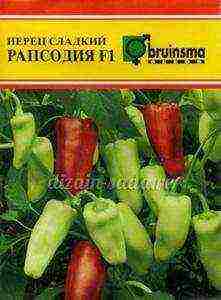
Pepper Rhapsody F1, characteristic
An early, high-yield sweet pepper hybrid. Ripens on 73-75 days from the moment the seedlings are planted in the ground. The height of the bush is 65-75 cm. The hybrid is very unpretentious, bears fruit in almost any, even "bad" year.
Fruits are conical, long (15-16 cm), wall thickness 6-7 mm. At biological maturity, the peppers are yellow.
The hybrid is resistant to tobacco mosaic virus and stress conditions.
We recommend purchasing pepper seeds in the Sady Rossii online store
Which sweet peppers do you think are the best? Where do you grow them in a greenhouse or outdoors? Have you tried growing purple or black varieties? Which taste better: red, yellow or black? Please share your opinion in the comments.
Bell peppers are a thermophilic annual plant originating in America. Prized for its unique taste and high vitamin content... In the article we will consider early, mid- and late-ripening varieties, talk about hybrids, and offer varieties for stuffing.
Early varieties of bell peppers for open field
The early varieties are called allowing for a short period of time (70-120 days) to get a high yield... Most species can be grown in unprotected soil. Description and characteristics of the best varieties are presented below.
Big Mama
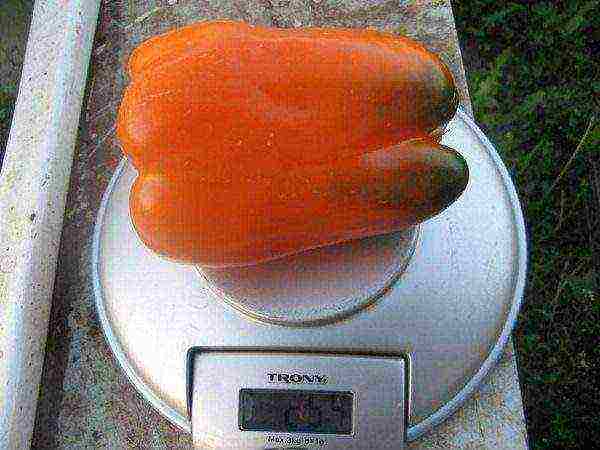 Early variety of Big Mama pepper
Early variety of Big Mama pepper
Fruits are large (200g) of warm orange rectangular shape. A bush in a greenhouse can grow up to 1 m, in unprotected soil - 50-70 cm... Excellent taste both fresh and after heat treatment.
Merchant
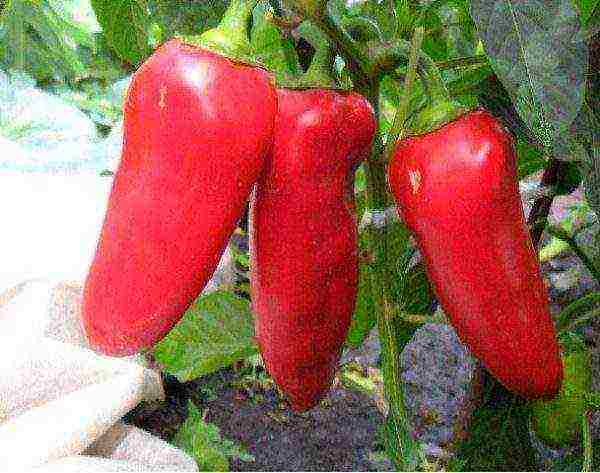 Sweet pepper grade Kupets
Sweet pepper grade Kupets
Medium-sized plant with pyramid-shaped fruits. During biological maturation, they are dark red in color, with a juicy dense pulp.... Peppers are large-fruited, thick-walled.
Mid-season
The varieties of medium ripeness include those the growing season of which occurs in the range from 110 to 130 days... This species is distinguished by the duration of fruiting.
Martin
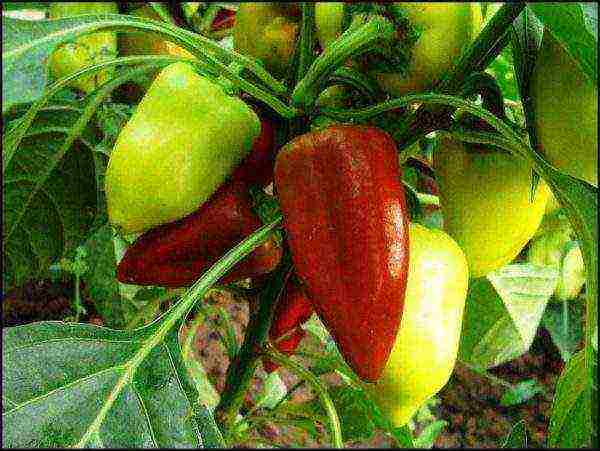 Sweet pepper swallow
Sweet pepper swallow
A variety with high seed germination. Fruits are cone-shaped, red. Length of ripe pepper Swallow up to 10 cm... The bush is small, about 50 cm.
Atlant
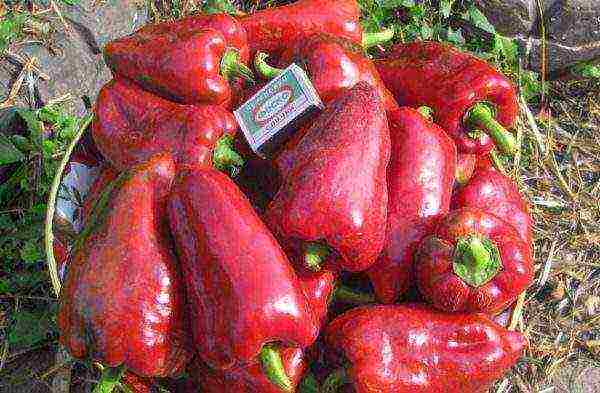 Tall variety Atlant pepper
Tall variety Atlant pepper
A tall variety with a fairly large yield. Atlant fruits are large (400g), sweet, deep red, thick-walled (1 cm). Peppers grow up to 20 cm in length... Disease resistant.
Sweet pepper for Siberia
Bell peppers come from hot countries, they like the warm temperate climate. But even in such a harsh region as Siberia, you can grow peppers and get an excellent harvest. There are many varieties for the colder climates. Which ones to use in the area? Summer in Siberia is short, so it is better to use early or mid-early peppers. The most common among them are the following:
Dandy
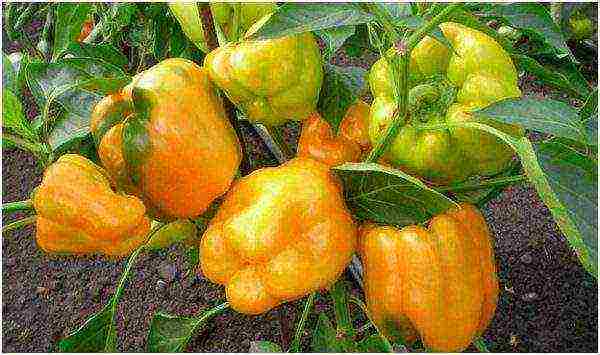 Pepper grade Goldfinch
Pepper grade Goldfinch
An early variety with a low bush (up to 50 cm). The vegetables are cylindrical, dark yellow when ripe... The thickness of the pulp is 5-8 mm.
Moneybags
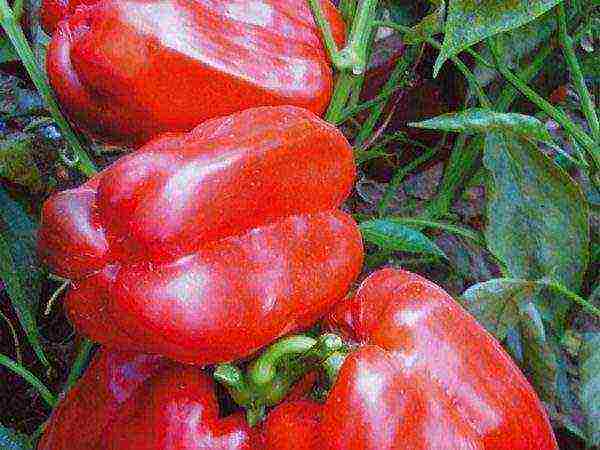 Pepper grade Tolstosum
Pepper grade Tolstosum
A new variety bred in Siberia. Resistant to cold, grows well in unprotected soil. Strong bush, up to 60 cm. Ripe red vegetable, large. The thick wall of the pulp tastes sweet and juicy.
Golden Taurus
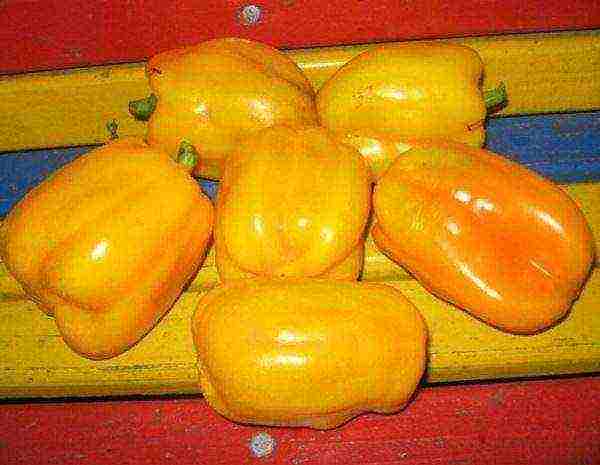 Siberian pepper variety Golden calf
Siberian pepper variety Golden calf
Medium early crop, well suited for growing in Siberia. Bushes of medium height. Fruits are orange, glossy, cuboid... The wall of the vegetable pulp is very thick, up to 20 mm.
Sweet chocolate
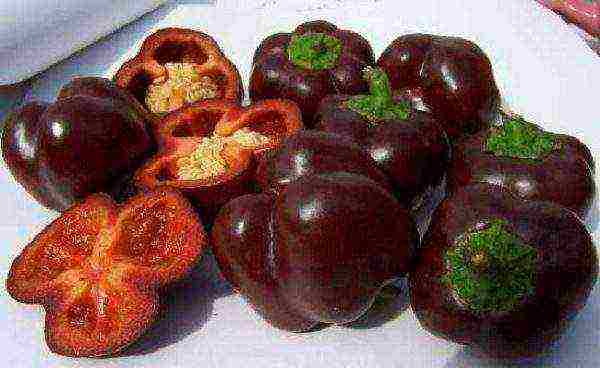 Pepper grade Sweet chocolate
Pepper grade Sweet chocolate
Unusual due to its paint. The fruit is dark brown in color, while the flesh is red inside... The pepper is very juicy and sweet in taste, ideal for preservation.
Varieties for the Moscow region
For the changeable climate of the Moscow region, varieties should be selected that are resistant to a sharp change in temperature. The following are popular among gardeners:
gold medal
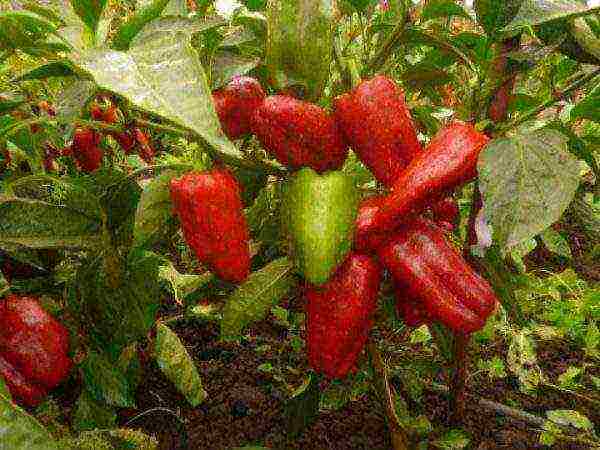 Pepper grade Gold medal
Pepper grade Gold medal
High-yielding, can grow in unprotected soil. The bushes are high (up to 1 m). Fruits are straight, long (up to 13 cm) with an average wall thickness.
Belozerka
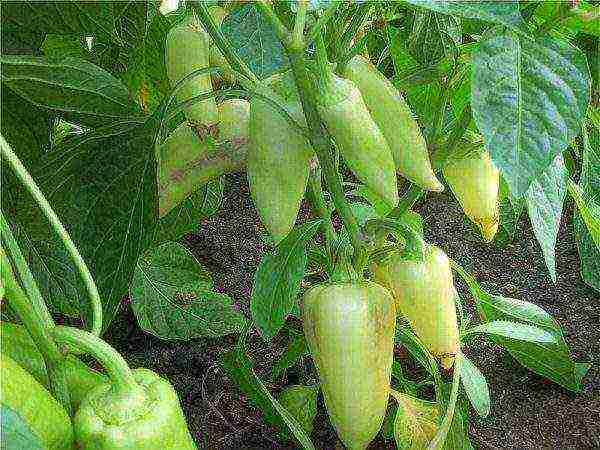 Sweet pepper grade Belozerka
Sweet pepper grade Belozerka
Belozerka is resistant to climate change and has a high yield. On low bushes (50-80cm), small cone-shaped hearths are formed... The color changes from light green to red towards the end of ripening.
Winnie the Pooh
 Pepper winnie the pooh
Pepper winnie the pooh
The bushes are low, suitable even for the smallest greenhouses. Winnie the Pooh Grows well outdoors. Fully ripens in 100 days. Fruits are small (10 cm), smooth, in the shape of a sharp cone. The color of ripe pepper is bright red, the thickness of the flesh wall is 6 mm.
Gogoshary
 Pepper grade Gogoshary
Pepper grade Gogoshary
Medium early variety (95-100 days). It has an unusual flattened shape, reminiscent of a pumpkin. The bushes are tall, strong (up to 1 m). Fruits are thick-walled, fleshy, dark green at the beginning of ripening, deep red at biological maturity... It has an interesting sweet-spicy taste, good both fresh and after heat treatment.
The best hybrid varieties
The seeds of hybrid varieties are not suitable for further planting. therefore seedlings will have to be bought every year... But such qualities as high resistance to diseases, productivity and impressive size of fruits make gardeners from year to year acquire exactly the seeds of hybrid plants.
Marinkin tongue
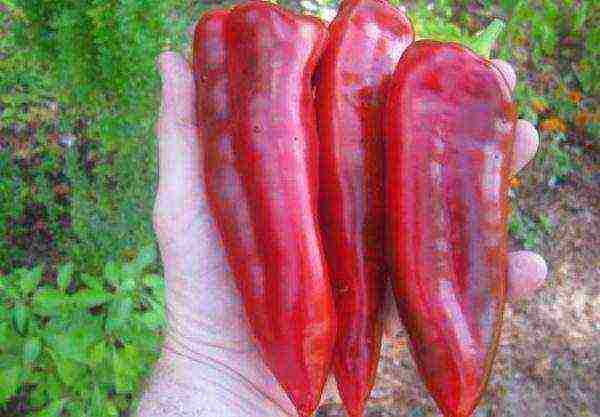 Pepper grade Marinkin tongue
Pepper grade Marinkin tongue
Medium height plant, with rather large fruits (up to 200 g) of a long elongated shape... The taste is sweet, very pleasant, but the shelf life of these peppers is not long.
Triton
 Extra early pepper Triton
Extra early pepper Triton
Incredibly high yield - more than 50 peppers can grow on one bush! The shape of the fruit is conical, the wall is not thick. The ripe fruit is bright red in color, ideal for processing.
Atlantic
 Hybrid pepper variety Atlantic
Hybrid pepper variety Atlantic
The classic representative of culture. Large fruits of bright red color, very juicy and aromatic... It is widely used for preparations and in fresh appetizers and salads.
Description of the best late-ripening peppers
Most suitable for southern latitudes, since they need 140-150 days with good weather to fully ripen.
Hercules
 Pepper Hercules
Pepper Hercules
Stunted, has many large fruits. Ripe Hercules peppers are red, with thick juicy pulp.
Yellow bell
 Pepper Yellow Bell
Pepper Yellow Bell
Plant of medium height (up to 75 cm) with large yellow-orange fruits when ripe. Shaped like an inverted bell... It has a thick flesh wall and excellent fresh taste.
Bogatyr
 Pepper Bogatyr
Pepper Bogatyr
The hero is not afraid of open ground. Bushes are small, with large fruits. Ripe, cube-shaped pepper of bright red color with juicy pulp, has a great taste and aroma.
Marshmallow
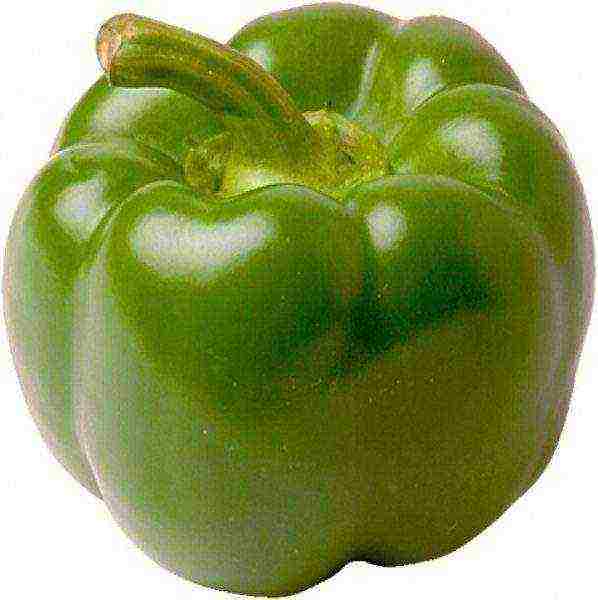 Pepper grade Marshmallow
Pepper grade Marshmallow
High yielding, vigorous plant (up to 80 cm) with a large number of globular fruits... The pulp is very juicy and sweet. The color changes from deep green to bright red.
Thick-walled large-fruited varieties
Wall thickness and fruit size are decisive factors for most gardeners when choosing seeds. Thick-walled peppers are with a pulp thickness of 6mm. These varieties are great for canning, drying and freezing.
White gold
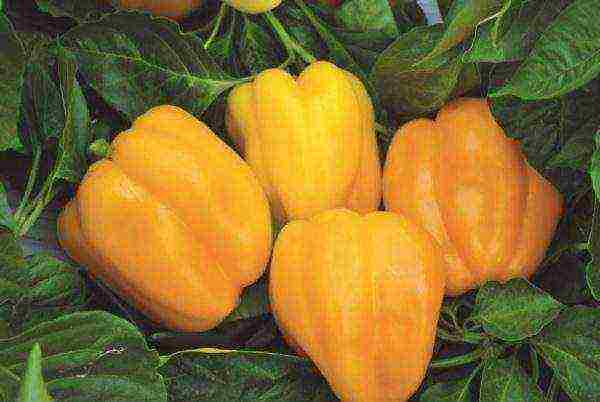 Pepper grade White gold
Pepper grade White gold
Can be planted in open ground. The plant is low, while with very large yellow fruits (up to 450g)... The peppers are cubic in shape.
Siberian format
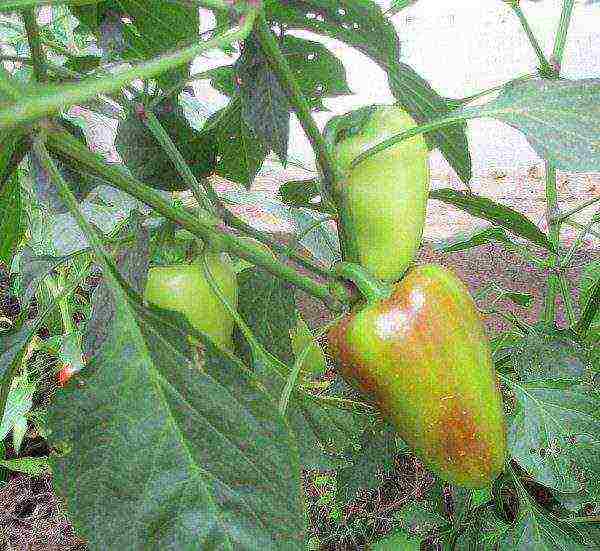 Sweet pepper variety Siberian format
Sweet pepper variety Siberian format
Mid-season, very large peppers grow on tall and powerful bushes. The size of the fruit grown in the greenhouse can be up to 500 g!
Queen
 Sweet Pepper Queen
Sweet Pepper Queen
Fruitful, small fruit (up to 200g) has a thick ruby-red flesh. It perfectly tolerates long-term transportation.
The best peppers for stuffing and processing
Stuffing
 Stuffed bell pepper
Stuffed bell pepper
Pepper is ideal for food stuffing. For this, even, medium-sized peppers of the same size are usually used. Among the early ones it can be noted: Lyubava, Divo, Golden miracle, Banana, Marinkin tongue. Among mid-season: Antey, New Russian, Stepashka.
Drying
Long and elongated fruits are suitable for drying.... Sabelka and Miracle paprika are perfect for this. You can dry them directly in the fresh air.
Canning
 Canned bell peppers
Canned bell peppers
For preservation, it is ideal to use thick-walled fleshy varieties. And if you take a few multi-colored peppers, the preparation will come out not only tasty, but also beautiful. Perfect for canning: Vanguard, Adept, Bogdan, Ideal, Lilac Bell, Chocolat Beauty, Amber.
Conclusion
Bell pepper is an unusually healthy, tasty and beautiful vegetable.It is grown in regions with different climatic conditions - Siberia, Moscow region, Donbass, Crimea and others. Thanks to the bright variety of colors and juicy fresh taste, it will always find a place on the festive table. And in terms of filling with vitamins, pepper is the leader among other vegetables. By eating just one pepper a day, you can replenish your daily supply of vitamins C and E. Bell peppers are called "the vegetable of beauty", because eating it improves the skin and strengthens the hair. Pepper is also good for the eyes, due to the high content of beta-carotene.
Bell peppers have become an everyday vegetable and are often used for cooking. This crop is grown in every vegetable garden, regardless of the region. You can grow it and harvest it almost everywhere by choosing the right variety. Today we will get acquainted with the best varieties of sweet peppers.
This is a typical member of the nightshade family. The fruit is a hollow false berry with a lot of seeds. Color from pale yellow to brown and purple. In its homeland, in Central America, it belongs to perennial plants, but in the conditions of the Russian climate it is grown as an annual.
In the southern regions of the Lower Volga region, in the North Caucasus, in the Krasnodar Territory, it gives rich harvests in the open air, and in more northern regions temporary or permanent shelters are needed.
Popular varieties of bell peppers
Early and mid-season varieties for open ground
Big Mama
It is grown both outdoors and in various shelters. Semi-spreading bush reaches a height of 1m. Individual fruits grow up to 200 g in weight, their walls reach 13 mm in thickness. Rectangular and smooth false berries turn attractive orange when technically ripe. Ripen in 120 days. The Big Mama peppers received a high tasting rating. The crop is used fresh, suitable for conservation, and is indispensable in cooking.
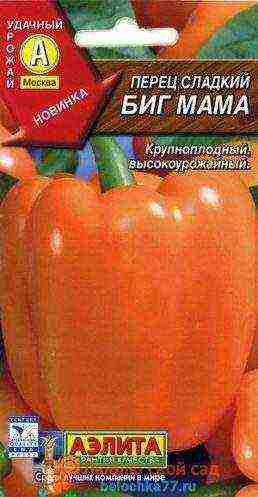
Bogatyr
A typical representative of mid-season varieties. From the emergence of seedlings to the technical ripeness of the fruit, no more than 120 days pass.
On a tall and spreading bush (up to 60 cm) prism-shaped, rather large fruits ripen. With the onset of ripening, the slightly bumpy skin acquires a pale green color, which eventually turns into red. Up to 7 kg of peppers with 5.5 mm walls are obtained from one square meter. Moreover, each pepper can weigh 150-180g.
The variety accumulates a lot of ascorbic acid, rutin, and many useful trace elements in the pulp. The taste is very high.
The fruits are used fresh, used for cooking hot dishes, processed into canned food and frozen.
Peppers of this variety tolerate transportation and are resistant to diseases typical of nightshades.
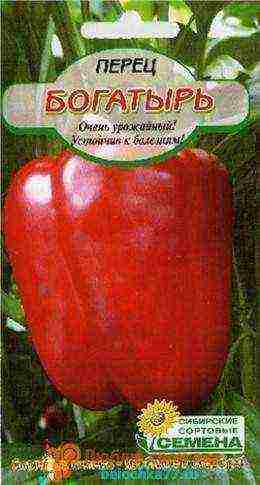
Martin
The early ripening variety Swallow can be harvested in 130 days. The fruits ripen together. Can grow outdoors and under temporary cover.
To obtain a rich harvest, it is necessary to form a bush correctly - remove all the leaves before the first branch. Medium spreading bush grows up to 60 cm. Smooth cone-shaped fruits hang from lateral branches. The light green color will tell you that the crop can be harvested. At this time, the fruits will reach 70 g in weight, and the flesh is 5 mm thick.
The high yield of the variety, tasty fruits, versatility of use and resistance to diseases make it possible to recommend this variety for growing in a summer cottage.
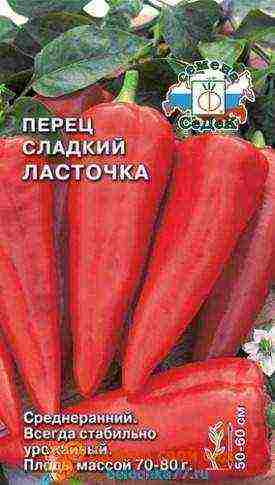
Merchant
Another early maturing variety recommended for open ground and greenhouses. Begins to bear fruit in over 100 days. Pyramidal peppers ripen on semi-spreading bushes that grow up to almost 1 meter. Ripening, the fruits turn light green, biologically ripe peppers - red. They have excellent taste, the weight of one fruit reaches 130 g.
Peppers "Kupets" have a characteristic aroma, are rich in vitamin C. The variety regularly gives a stable yield (up to 2.5 kg / m2), universal purpose.
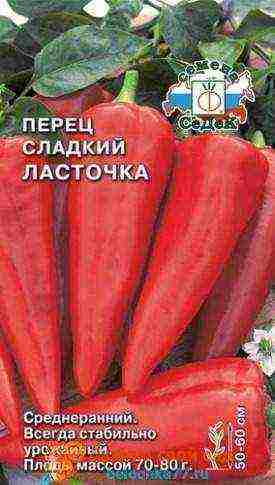
Atlant
The large cone-shaped fruits of Atlanta do not fit in any way with the modest, not very tall and spreading bushes. The leaves are also disproportionate to the outstanding fruits.
Atlanta has three-chambered peppers, dense, fleshy crunchy. When ripe, they become very sweet and juicy. The walls of the pepper reach 6 mm, with a total weight of an individual fruit up to 165 g.
You can collect them as early as 110 days. At this time, the fruits turn bright green. Productivity - 3-5 kg of pepper per 1 m2.

Belozerka
Bell pepper Belozerka is one of the most commonly grown varieties. It bears fruit abundantly outdoors. Ripens in 112 days. Bushes up to 70 cm. Conical, hanging fruits, slightly ribbed with a sharp top, painted in colors from light cream to red. Pulp thickness 7.5 mm, weight 130 g.
Delicious fruits for universal use. Ripen amicably. The yield can be up to 8 kg / m2. Stored for a long time, do not deteriorate during long-term transportation. Plants are resistant to diseases and various rot.
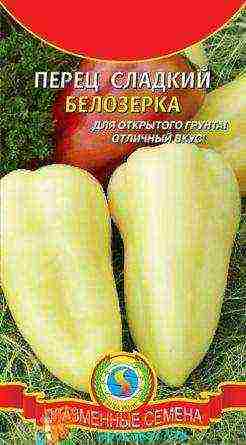
Big Daddy
Compact plants bear fruit outdoors and under temporary shelter. 90 days after planting the seedlings, you can collect thick-walled (8 mm), cone-shaped, very tasty fruits weighing 150 g. The purple fruits have reached technical ripeness and are ready to be harvested. Biologically ripe fruits are red-brown. Peppers keep fresh for a long time, do not spoil when transported over long distances. Productivity from 6 to 8 kg of fruits of high commercial quality.
Medium bush, moderately leafy
The high-yielding variety is resistant to diseases, in particular to the tobacco mosaic virus.
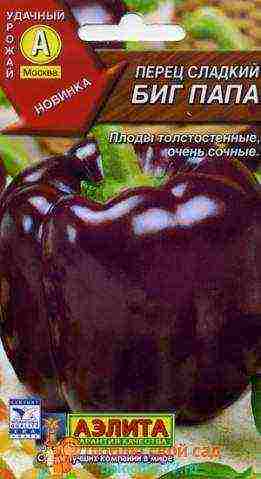

California miracle
A very productive medium early variety, you can harvest in 110-130 days. Can be used fresh, suitable for conservation. The fruit of a cuboid shape is juicy, sweet grows up to 150g. Wall thickness up to 8mm. In technical ripeness, the peppers are dark green, when ripening, they turn red. The plant is powerful, up to 1m in height.
The California miracle can be grown under temporary shelter and outdoors. Harvest up to 3 kg / m2. Decent commercial qualities.

Orange miracle
Ripens in 100-110 days. Designed for temporary shelters and open ground. Zoned in the southern regions of Russia.
A powerful bush grows above 1 meter. Resistant to the tobacco mosaic virus. Cuboid, bright orange fruits ripen on such a plant. The pulp is tender, juicy, up to 10mm thick. The weight of an individual pepper can be up to 250g. The yield of the variety is up to 14 kg / m2.
The collected very tasty fruits have high commercial qualities, are used fresh, harvested for future use.

Gogoshary
One of the best mid-season varieties. He has high taste and marketability. Disease resistant. Can be grown in open and protected ground.
Rounded fruits are dark green at first, redden to full ripeness. Up to 10 cm in size, with sweet juicy pulp and a wall thickness of 5-6 mm. Fruit weight from 50 to 75 g. After 4 months ripe peppers can be harvested. Harvest up to 5 kg / m2.
The bush is undersized, compact, no higher than 50 cm.
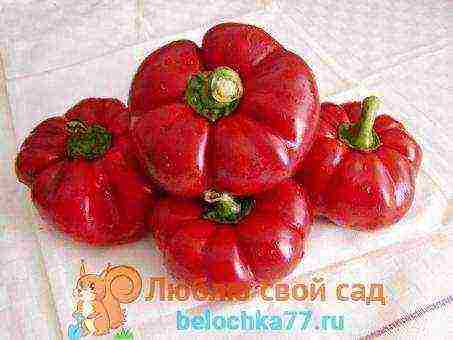 Pepper Gogoshary
Pepper Gogoshary
Gladiator
Gladiator fruits contain an increased amount of ascorbic acid, tasty, with high commercial qualities.
The variety is resistant to verticillium. Can be grown under temporary shelter and outdoors.
Peppers of this variety are yellow in color, with a delicate sweet pulp with a delicate peppery aroma. Wall thickness 5-6 mm, weight up to 250g.
From sowing to ripening ripeness, 100-115 days pass.
A vigorous, spreading bush feels better in areas closed from the wind. Estimated yield 4-5 kg / m2.
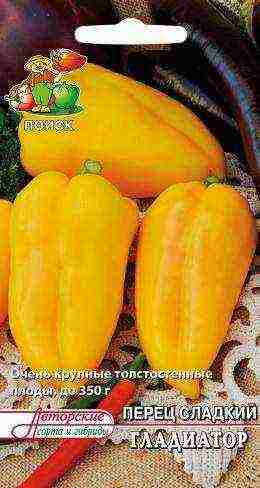 Sweet pepper GLADIATOR
Sweet pepper GLADIATOR
Polycarbonate greenhouse varieties
Miracle Tree F1
The Miracle tree hybrid confirms this name. Pepper bush 180 cm high! When other varieties are just beginning to bloom, many fruits have already begun to grow on the "Tree". The peppers are medium in size, fiery red, up to 100 g in weight, prismatic, very tasty and juicy. The thickness of the pulp is 4-6 mm.
The hybrid is recommended for growing in a greenhouse. High quality fruits are formed even with a lack of light. Resistant to apical fruit rot disease. Ripen amicably. The harvested crop is suitable for fresh use, good for processing.  Pharaoh F1
Pharaoh F1
Hybrid, for greenhouses and open ground. It takes a little more than two months from planting seedlings to collecting the first fruits.
A medium sized bush of moderate height. Fruits drooping, prism-shaped, covered with glossy skin. Ripe fruits are yellow, later they turn red. The weight of one pepper with a wall thickness of 7-8 mm can reach up to 160g. The taste of the harvested fruits is unsurpassed, the harvest is used fresh, suitable for processing. From one square. m collect 6 to 7.5 kg. The hybrid does not reduce yields in adverse weather conditions, and is immune to viral diseases.

Fat Baron
Pepper variety Tolstoy Baron is recommended for sowing in the south of Russia. Good for indoor and outdoor cultivation. In the conditions of the middle zone and the Urals, it is better to grow in a greenhouse.
The pepper bush does not grow higher than 55 cm. Despite such compactness, it needs support, because up to 15 fruits can ripen on it at the same time. The variety is resistant to infectious and viral diseases.
Fruits are cone-shaped, pleasantly sweet, 10-12 cm long, grow up to 140 g. Ready for harvest in July-September, after 120-140 days. Peppers with high consumer qualities.
Fruits ripened to technical ripeness are pale green, gradually turning red when fully ripe. Walls when harvesting about 6mm. The total yield reaches 5kg / m2. Applied fresh, suitable for future use.

Cow's ear
Mid-early ripening period. From sowing seedlings to ripening of the first fruits, a little more than 70 days.
The bush grows up to 70 cm. The peppers are thick-walled (6-8mm), elongated-conical, smooth. Sixteen-centimeter fruits can weigh up to 200g.
Biologically ripe fruits are rich red, juicy and sweet. Stored for a long time. Well tolerates long-distance transportation. Up to three kg of fruits are removed from each bush.
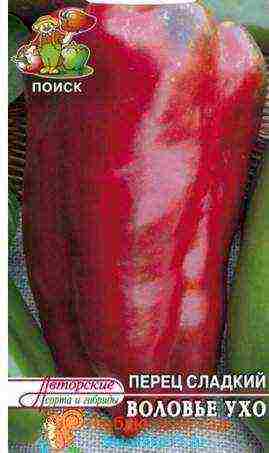
Cockatoo
Tall bushes, up to 1.5 m give up to 3 kg of pepper per bush. Giant fruits up to 30 cm long and weighing up to 500 g. Amazing peppers are elongated, cylindrical in shape, slightly curved. The pulp is thick, juicy, sweet, fragrant. The purpose of the fruit is universal - you can use it fresh, or you can preserve it.
The crop can be harvested 110 days after sowing the seeds. The cockatoo is zoned in the southern regions, with a lot of sunny days. It is very important that the planting site for seedlings of this variety is constantly illuminated by the sun.
Plants react painfully to lack of light. The dignity of the variety is resistance to diseases, rot, mosaic.
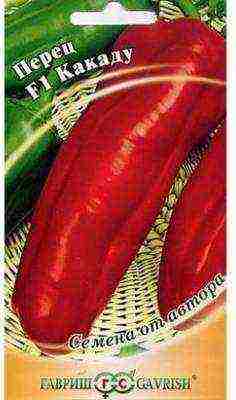
Gift from Moldova
A very productive variety. On a bush, no more than 0.5 m high, very beautiful and aromatic peppers ripen. This pepper can be grown in a greenhouse or outdoors. From germination to fruiting, it takes a little over four months. Recommended for cultivation in the south of Russia. Adapts to local conditions.
The paprika bush of the Podarok Moldova variety is compact, no higher than 45 cm. Semi-stemmed, with a large number of leaves. Resistant to some diseases.
Cone-shaped fruits are three-tetrahedral, about 10 cm long and weighing up to 90g. The walls are 4-5 mm thick. Ripe fruits are dark red, tasty and fragrant. Peppers of this variety ripen together and are suitable for mechanized harvesting.
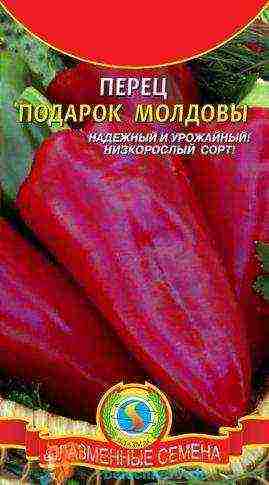
Topolin
Medium early variety with high quality fruits. The fruits are intended for fresh use and for processing. Zoned in the southern regions of Russia. The taste and market indicators of the fruit are high. The variety is resistant to vercyllous wilt. Fruits suitable for harvest are light green, dark red when fully ripe. Conical peppers, up to 10 cm long with juicy pulp up to 6 mm.
One fruit can weigh 100-150g.ready to harvest 110 days after sowing.
A slightly spreading bush in a variety is formed in a standard form, without a garter.
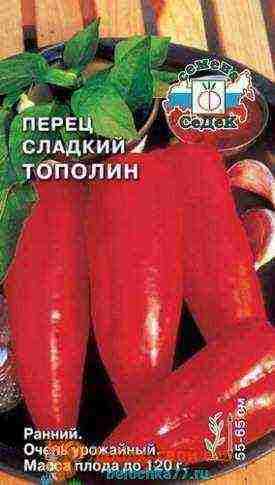
Ivanhoe
Bell peppers, ripening on day 115. High marketability and taste. Genetic immunity to many diseases and low temperatures. Can grow under temporary cover and outdoors. Bushes up to 70 cm high, compact.
The cream-colored fruits are suitable for harvesting, when fully ripe they turn red. Cone-shaped, with tender, juicy and sweet pulp. Two or three-chambered fruit gains weight up to 140g.
The crop can withstand long-term storage and long-distance transportation.
A yield of 7 kg / m2 is achieved only in a greenhouse.
Hercules
It is characterized by high, stable yield. Harvesting begins three months after sowing. Delicious fruits have high commercial qualities. Disease resistant.
Fruits are dark green at first, when ripe, they turn red.
The varietal feature is a cuboid shape with a wall thickness of almost 7 mm. The mass of pepper can reach 160g.
The bush reaches 80 cm in height. Average yield 3 kg / m2.
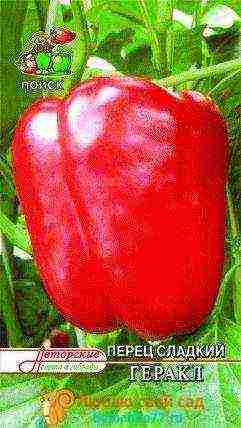
There is no way to describe all the varieties, here is another selection of the best varieties:
- The best early varieties for open ground are Funtik, Chardash, Barguzin, Kornet, Akkord, Buratino F1, Junga.
- Polycarbonate greenhouse varieties - Cardinal, Claudio, Atlant, Kakadu, Hercules, Denis, Orange miracle, Tenderness.
- Sweet pepper varieties for the Moscow region - Orange miracle, Cardinal, Atlant, Latino, Agapovsky, Atlantic F1, Pinocchio F1, Winnie the Pooh, Golden rain.
- Thick-walled pepper varieties - Kolobok, Hecules, Yellow bull, Red bull, Aeneas, Helios, Winnie the Pooh, Health, Viking.
- Varieties for the Urals and Siberia - Barguzin, Barin, Zolotinka, Ivolga, Kudesnik, Kupets, Pioneer.
You can read more about the varieties of pepper in the article "Varieties of pepper for the Urals".
Best regards, Sophia Guseva.
Other interesting articles:
- How to grow a pumpkin
- How to grow Brussels sprouts
- Irises - planting and care
- Growing oyster mushrooms at home
 From time immemorial, mankind began to cultivate land in order to receive the rich gifts of the land. Vegetables, fruits, cereals - all these products have become an integral part of the diet of any person.
From time immemorial, mankind began to cultivate land in order to receive the rich gifts of the land. Vegetables, fruits, cereals - all these products have become an integral part of the diet of any person.
Among vegetable crops, sweet peppers or bulgarian peppers occupy a particularly important place. It is interesting that bell peppers are called mainly in Russia. In other countries, it is known as paprika or bell peppers. This is due to the fact that after the "migration" of culture from Central America to Europe, and then to Bulgaria, sweet peppers found a "second wind" in the form of new varieties. Scientists of this country began to actively engage in selective breeding of the plant and bred the best varieties of sweet peppers, which were appreciated by the inhabitants of the Russian state at the very beginning of the 20th century, and then switched to bulk purchases of vegetables in Bulgaria. Since then, on the territory of Russia, all varieties of paprika are called Bulgarian.
Varieties of sweet peppers
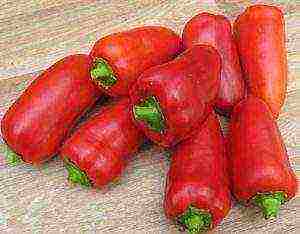 At the moment, a huge variety of pepper varieties have been bred. There are a large number of criteria affecting the selection of planting material, for example, for greenhouses. Choosing the seeds of the best varieties of sweet peppers should be based on the following characteristics.
At the moment, a huge variety of pepper varieties have been bred. There are a large number of criteria affecting the selection of planting material, for example, for greenhouses. Choosing the seeds of the best varieties of sweet peppers should be based on the following characteristics.
Ripening terms
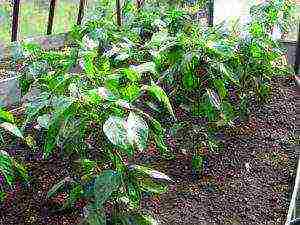 The timing of fruit ripening is the most important indicator, therefore, when choosing seeds, you need to pay attention to it first. In the northern regions, where summer is short, bell peppers may not ripen, and the effort will be in vain.
The timing of fruit ripening is the most important indicator, therefore, when choosing seeds, you need to pay attention to it first. In the northern regions, where summer is short, bell peppers may not ripen, and the effort will be in vain.
For example, residents of the Moscow region have already identified the most suitable varieties for themselves. The answer to a common question: what are the best varieties of sweet pepper for the Moscow region - reviews of people who have tested in practice the suitability of certain varieties of vegetables for greenhouse cultivation in this region. The most popular varieties are Dobrynya, Aries, Mercury F1. Farmers assessed their early maturity (90-95 days) and yield (12-14 kg / sq. M.).The best varieties of sweet peppers for a greenhouse near Moscow: Bagration, Nochka F1, Alyonushka, Orange King, Cardinal, Latino F1.
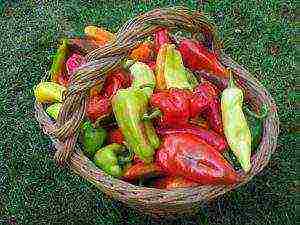 The best varieties of sweet peppers for the Moscow region, suitable for cultivation "under the open sky", have also been identified: Atlantic, Gogoshary, Golden Taurus. All three varieties have in common that they belong to medium early varieties, can be grown without a film cover, and give a good harvest.
The best varieties of sweet peppers for the Moscow region, suitable for cultivation "under the open sky", have also been identified: Atlantic, Gogoshary, Golden Taurus. All three varieties have in common that they belong to medium early varieties, can be grown without a film cover, and give a good harvest.
The most urgent issue is the early ripening of fruits for residents of the northern parts of Russia, for example, for the Urals. The most suitable varieties of sweet peppers for the Urals: Montero, Pioneer, Kupets, Bogatyr, Red (or Yellow) Bull, Winnie the Pooh. All of them are the best varieties of sweet peppers for the Urals for the winter, since they are ranked among the early-maturing and mid-early varieties, they give a good harvest in unheated greenhouses, as well as outdoors under a film.
Pepper ripening time: early, medium, late
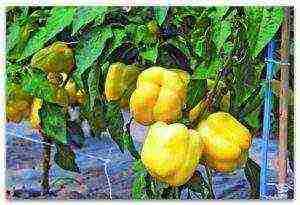 Early peppers are considered if the time from the moment the plant sprouts to the receipt of the first fruit is about 80 days (maximum - 100).
Early peppers are considered if the time from the moment the plant sprouts to the receipt of the first fruit is about 80 days (maximum - 100).
Medium sweet peppers. A medium-ripening plant will give fruit on the 115-130th day.
If the bell pepper belongs to the late varieties, then the ripening process will take up to 140 days.
Fruit color
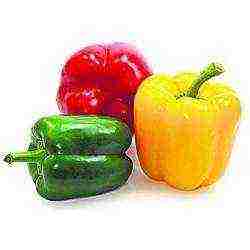 It would seem, why pay attention to the color of the pepper? After all, the color of the fruit only adds decorativeness to a particular variety. It turns out that in some cases, the color can tell something about the beneficial properties of the fruit. By growing a red vegetable, a person gets more vitamin C than, for example, yellow pepper. The yellow variety, in turn, is rich in potassium, which is essential for maintaining the health of the cardiovascular and nervous system. Orange sweet peppers "signal" the presence of carotene.
It would seem, why pay attention to the color of the pepper? After all, the color of the fruit only adds decorativeness to a particular variety. It turns out that in some cases, the color can tell something about the beneficial properties of the fruit. By growing a red vegetable, a person gets more vitamin C than, for example, yellow pepper. The yellow variety, in turn, is rich in potassium, which is essential for maintaining the health of the cardiovascular and nervous system. Orange sweet peppers "signal" the presence of carotene.
It should also be remembered that the color of the pepper changes during aging. At the stage of technical ripening, the fruits are usually green. Fully ripe vegetables take on the characteristic color of the variety.
Fruit shape
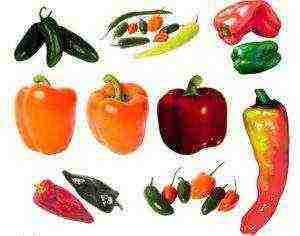 The shape of the bell pepper is different: cone-shaped, prism-shaped, almost round, similar to a cube. The shape of the vegetable is taken into account depending on the purpose for which it will be used. For example, round peppers, such as the Sunny variety, are best suited for stuffing.
The shape of the bell pepper is different: cone-shaped, prism-shaped, almost round, similar to a cube. The shape of the vegetable is taken into account depending on the purpose for which it will be used. For example, round peppers, such as the Sunny variety, are best suited for stuffing.
"Place of residence"
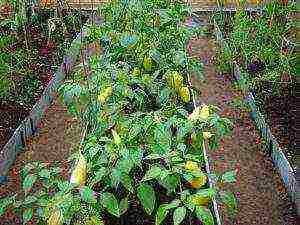 When choosing seeds, one should not forget about the conditions in which the pepper will "live": greenhouse, "fresh air", room. Each pack of seeds indicates whether the plant should be grown in an open, closed ground or on a loggia in an apartment. When purchasing seed, it is advisable to pay attention to the packaging of the seeds, where the conditions for growing the plant are indicated. Many greenhouse sweet pepper seeds are unlikely to yield the promised outdoor yield. Today, the best varieties of sweet peppers for greenhouses include the following representatives: California Miracle, Agapovsky, Atlant F1, Apricot Favorite, Belladonna F1, Star of the East, Swallow, Cardinal F1, Bogatyr, Isabella F1.
When choosing seeds, one should not forget about the conditions in which the pepper will "live": greenhouse, "fresh air", room. Each pack of seeds indicates whether the plant should be grown in an open, closed ground or on a loggia in an apartment. When purchasing seed, it is advisable to pay attention to the packaging of the seeds, where the conditions for growing the plant are indicated. Many greenhouse sweet pepper seeds are unlikely to yield the promised outdoor yield. Today, the best varieties of sweet peppers for greenhouses include the following representatives: California Miracle, Agapovsky, Atlant F1, Apricot Favorite, Belladonna F1, Star of the East, Swallow, Cardinal F1, Bogatyr, Isabella F1.
The best option for the garden
![]() Everyone wants to grow the best pepper, which would be the largest, most delicious, beautiful and juicy. Having tried to compile a rating of bell peppers based on its best indicators, you can get the following picture.
Everyone wants to grow the best pepper, which would be the largest, most delicious, beautiful and juicy. Having tried to compile a rating of bell peppers based on its best indicators, you can get the following picture.
The largest pepper
The purchase of quality seeds of giant peppers increases the likelihood of getting a high yield of large, juicy "elephants" weighing up to 0.5 kg. Experienced vegetable growers have identified the largest varieties of sweet peppers, yielding simply gigantic fruits:
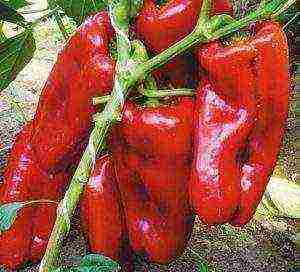 Cockatoo F1. It is famous for its large-fruited nature. One fruit of the plant reaches a mass of 500 g. The cylindrical vegetable is colored juicy red. The walls are strong - 6-8 mm.
Cockatoo F1. It is famous for its large-fruited nature. One fruit of the plant reaches a mass of 500 g. The cylindrical vegetable is colored juicy red. The walls are strong - 6-8 mm.- Bull. A fully ripe yellow fruit weighs between 0.3 and 0.5 kg. The walls are thick, reaching up to 1 cm.The length of the fruit is 30 cm.
- King Kong. It can also please with half-kilogram fruits of a cylindrical, slightly curved shape.The rich red walls of the vegetable reach 6-9 mm in thickness.
In addition, other varieties of southern vegetables are among the varieties that give the most massive peppers: Atlant, Gems, Volovye Ukho, Bogatyr, Bychok, Red Spade, Big Papa.
The most productive pepper
An important role in obtaining a good harvest is played by the yield indicator of the variety.
What are the most productive varieties of sweet peppers loved by domestic farmers? Which plant brings the most succulent, aromatic production?
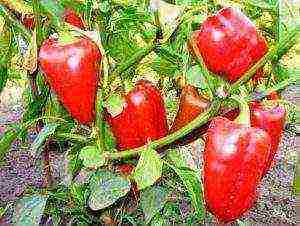 The first place in this category is rightfully taken by the mid-season California miracle pepper. It is easy to guess from the name that the variety was bred by American breeders. One bush of a plant can produce 7-10 "cubic" fruits, weighing about 150 grams. If you measure the yield in the number of kilograms harvested from 1 m2, then the yield of the California miracle will be 10 kg.
The first place in this category is rightfully taken by the mid-season California miracle pepper. It is easy to guess from the name that the variety was bred by American breeders. One bush of a plant can produce 7-10 "cubic" fruits, weighing about 150 grams. If you measure the yield in the number of kilograms harvested from 1 m2, then the yield of the California miracle will be 10 kg.- The sweet pepper variety Volovye ear is no less popular. Mid-season pepper, giving good results when grown both in greenhouses and outdoors. On average, one bush of the Ox's Ear gives 2-3 kg of yield per bush. The fruits are triangular, ribbed, and really resemble a bull's ear in shape. The weight of 1 fruit "holds out" up to 200 g, and the length - up to 12-16 cm. In the technical phase of ripening, the vegetable is green, later - red.
- Pepper Atlant is one of the three leaders in terms of productivity, since, subject to all agrotechnical rules, this early ripening variety gives 3-5 kg of vegetables per 1m2. Cone-shaped fruits gain a mass of 110-160 grams, but some managed to grow larger specimens - up to 400 grams. Fully ripe peppers are bright red in color.
Other varieties of bell pepper also showed good yield indicators: Mammoth, Golden Calf, Don Pedro, Three Fat Men, Gems, Fat Baron, Kolobok.
Earliest pepper
Ripening time is perhaps the most important factor to consider when choosing peppers for planting. Early varieties in this sense occupy a leading position, since they allow a guaranteed harvest in the northern regions, and in the southern regions, early peppers are sometimes used to obtain two harvests per season.
Most of all, the early varieties of sweet peppers for open ground, suitable for greenhouses, have earned the trust of vegetable growers:
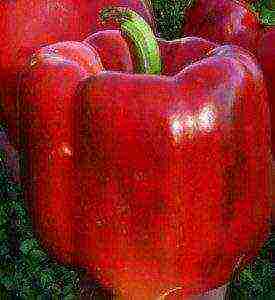 Red Square. A very early variety of pepper, which begins to yield crops as early as 85-90 days after germination. Fruits are cuboid, thick-walled, slightly elongated, average weight - 260 g, but can reach 400 g. An especially important point: the harvest of the Red Square pepper well tolerates long-term storage and transportation.
Red Square. A very early variety of pepper, which begins to yield crops as early as 85-90 days after germination. Fruits are cuboid, thick-walled, slightly elongated, average weight - 260 g, but can reach 400 g. An especially important point: the harvest of the Red Square pepper well tolerates long-term storage and transportation.- Ivanhoe. The variety has earned many accolades, primarily for its early yield. Already on the 115th day it will be possible to taste the first vegetable. The cone fruits of the variety are small, only 95-140 g, but the fertility indicators are high - 6-7 kg / m2. Ivanhoe pepper is stored well, suitable for "long trips".
- Funtik. The Funitk variety is well known to lovers of this vegetable crop for the opportunity to get fresh pepper in a short time. For 100-110 days, the peppers ripen to technical ripeness, when the fruits are still painted in a pale green color, but are already ready for consumption. On the 125-130th day, biological ripeness comes, the vegetables turn red. In addition, many appreciated its ability to bear fruit abundantly. One bush is able to "reward" with eighteen cone-shaped fruits (weighing 140-1480 grams).
The shortest pepper
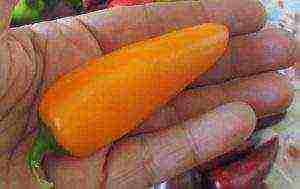 In the cramped conditions of small personal plots, it is very important to place all your favorite garden crops. Often the most productive peppers are tall plants that require a lot of space. In addition, there is a problem with props, to which you need to attach a bush so that it does not break under the weight of the fruit and does not end up on the ground.These problems can be easily avoided by choosing the shortest varieties of bell peppers for your garden plot.
In the cramped conditions of small personal plots, it is very important to place all your favorite garden crops. Often the most productive peppers are tall plants that require a lot of space. In addition, there is a problem with props, to which you need to attach a bush so that it does not break under the weight of the fruit and does not end up on the ground.These problems can be easily avoided by choosing the shortest varieties of bell peppers for your garden plot.
What varieties of "small stature" are considered to be the best?
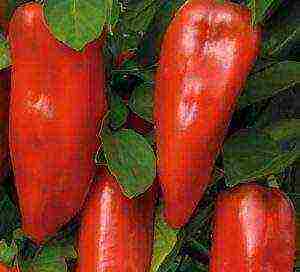 Chanterelle. An early variety of orange-colored pepper is compact and stunted. 5-6 bushes are freely placed on 1 square meter of land. With a constant dive of side shoots and the right growing conditions, you can get up to 2 kg of peppers from one bush. The fruits are medium-sized (25-45 grams), as they ripen, they change the color range from green to orange. An interesting feature of the variety is considered to be its unique ability to grow and bear fruit on the loggias of city apartments.
Chanterelle. An early variety of orange-colored pepper is compact and stunted. 5-6 bushes are freely placed on 1 square meter of land. With a constant dive of side shoots and the right growing conditions, you can get up to 2 kg of peppers from one bush. The fruits are medium-sized (25-45 grams), as they ripen, they change the color range from green to orange. An interesting feature of the variety is considered to be its unique ability to grow and bear fruit on the loggias of city apartments.- Fakir. An excellent undersized option for a summer cottage, since the pepper bush will not grow higher than 50-70 cm. The first peppers will appear on the bush on the 85-120th day after the seedlings have "hatched". The period between technical and biological ripeness is short. Fruits-cones of medium size (35-65 gr), ripening, pass from yellow to red color.
- Sveta. The height of the bush of this variety does not exceed 60 cm. Fruits are medium (60-80 gr), cone-shaped, they pass from technical to biological ripeness, changing the light green color to orange-yellow. Disease resistance is good.
Slight growth is also typical for the following sweet pepper varieties: Agapovsky, Eroshka, Albatros F1, Gemini F1, Timoshka, Ilya Muromets.
The thickest pepper
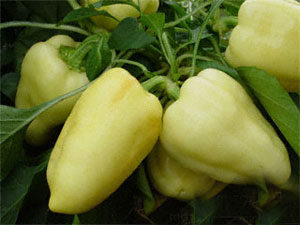 Sometimes the decisive role in the selection of seeds is played by the wall thickness of the pepper. It is very important for lovers of this product to choose the best varieties of sweet peppers with thick walls for preparing all kinds of fresh and pickled salads. The following varieties of sweet peppers with thick walls (more than 6 mm) and juicy pulp can boast of positive reviews: Red Giant, California Miracle, Volovye Ear, Fat Man, Anastasia, Belozerka, Kolobok, Fat Baron. By the way, all of the listed representatives are the most acceptable varieties of thick-walled sweet peppers for open ground, giving a bountiful harvest without covering with a film.
Sometimes the decisive role in the selection of seeds is played by the wall thickness of the pepper. It is very important for lovers of this product to choose the best varieties of sweet peppers with thick walls for preparing all kinds of fresh and pickled salads. The following varieties of sweet peppers with thick walls (more than 6 mm) and juicy pulp can boast of positive reviews: Red Giant, California Miracle, Volovye Ear, Fat Man, Anastasia, Belozerka, Kolobok, Fat Baron. By the way, all of the listed representatives are the most acceptable varieties of thick-walled sweet peppers for open ground, giving a bountiful harvest without covering with a film.
Bell peppers are a vegetable that people love for their pleasant taste and healing properties, which make the vegetable an indispensable ingredient in many summer salads and other dishes. The correct choice of sowing material largely determines the quality of the future harvest, so you should take a responsible approach to solving this problem. Specialized stores will help in this, where you can choose a variety that takes into account all the wishes of the farmer.
